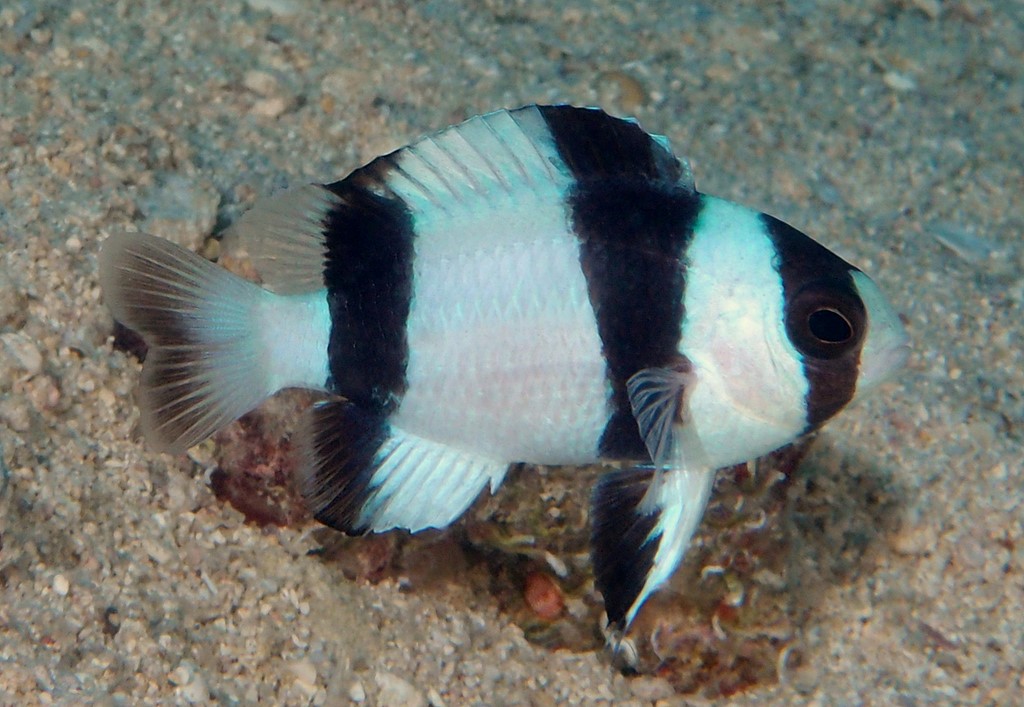AMBLYPOMACENTRUS TRICINCTUS - (ALLEN & RANDALL, 1974)
Actinopterygii (Gigaclass) > Actinopteri (Class) > Teleostei (Subclass) > Blenniiformes (Order) > Pomacentridae (Family) > Pomacentrinae (Subfamily) > Amblypomacentrus (Genus)
Demoiselle à trois bandes, Tuxedo damselfish, Three-band damsel, Threeband damselfish, Threeband demoiselle, Misuji suzumedai, ミスジスズメダイ, 三带金翅雀鲷, 三斑金鳍鲷,
Synonymes
Chrysiptera tricincta (Allen & Randall, 1974)
Glyphidodontops tricinctus (Allen & Randall, 1974)
-------------------------
Description
Dorsal spines (total): 13; Dorsal soft rays (total): 11-13; Anal spines: 2; Anal soft rays: 12-14; Pectoral fin rays: 18-19; Lateral line scales: 15-17; Gill rakers: 23-26; Body depth: 2.0-2.4 in Standard Length. Max. length: 6.0 cm TL. Depth range: 10 - 90 m, usually: 10 - 38 m.
Color
White body color with three prominent black bands running vertically within the body of the fish.
Etymology
Amblypomacentrus: from Greek, amblys or amblus = dull (blade: not sharp), blunt, obtuse + from Greek, poma, -atos = cover, operculum + from Greek, kentron = something with a sharp point: point, spike, spur, sting, quill, thorn.
tricinctus: from Latin, tri = three + from Latin, cinctum = a girdle, a belt. Referring to three black bars, one on head passing through eye, one at anterior dorsal fin passing to region behind pelvic fins, and one at posterior dorsal fin extending onto rear half of anal fin.
Original description: Glyphidodontops tricinctus Allen & Randall, 1974 - Type locality: Fagasa Bay, Tutuila, American Samoa, depth 75 feet.
Distribution
Western Pacific: southern Japan; western Coral Sea (Australia), New Caledonia, Fiji, and Samoa.
Biology
Adults inhabit lagoon and inshore reefs around coral or rock outcrops situated in sandy areas. Solitary. Diurnal species. Oviparous, distinct pairing during breeding. Eggs are demersal and adhere to the substrate. Males guard and aerate the eggs. It has some commercial importance as an aquarium pet.
Similar species
Dascyllus aruanus (Linnaeus, 1758) - Reported from New Caledonia - Link to the species (here).
Dascyllus melanurus (Bleeker, 1854) - Reported from New Caledonia. White body with three black bars on the body, black pelvic fins, and a black area over the outer two-thirds of the tail.
Last update: 24, May 2024
Demoiselle à trois bandes, Tuxedo damselfish, Three-band damsel, Threeband damselfish, Threeband demoiselle, Misuji suzumedai, ミスジスズメダイ, 三带金翅雀鲷, 三斑金鳍鲷,
Synonymes
Chrysiptera tricincta (Allen & Randall, 1974)
Glyphidodontops tricinctus (Allen & Randall, 1974)
-------------------------
Description
Dorsal spines (total): 13; Dorsal soft rays (total): 11-13; Anal spines: 2; Anal soft rays: 12-14; Pectoral fin rays: 18-19; Lateral line scales: 15-17; Gill rakers: 23-26; Body depth: 2.0-2.4 in Standard Length. Max. length: 6.0 cm TL. Depth range: 10 - 90 m, usually: 10 - 38 m.
Color
White body color with three prominent black bands running vertically within the body of the fish.
Etymology
Amblypomacentrus: from Greek, amblys or amblus = dull (blade: not sharp), blunt, obtuse + from Greek, poma, -atos = cover, operculum + from Greek, kentron = something with a sharp point: point, spike, spur, sting, quill, thorn.
tricinctus: from Latin, tri = three + from Latin, cinctum = a girdle, a belt. Referring to three black bars, one on head passing through eye, one at anterior dorsal fin passing to region behind pelvic fins, and one at posterior dorsal fin extending onto rear half of anal fin.
Original description: Glyphidodontops tricinctus Allen & Randall, 1974 - Type locality: Fagasa Bay, Tutuila, American Samoa, depth 75 feet.
Distribution
Western Pacific: southern Japan; western Coral Sea (Australia), New Caledonia, Fiji, and Samoa.
Biology
Adults inhabit lagoon and inshore reefs around coral or rock outcrops situated in sandy areas. Solitary. Diurnal species. Oviparous, distinct pairing during breeding. Eggs are demersal and adhere to the substrate. Males guard and aerate the eggs. It has some commercial importance as an aquarium pet.
Similar species
Dascyllus aruanus (Linnaeus, 1758) - Reported from New Caledonia - Link to the species (here).
Dascyllus melanurus (Bleeker, 1854) - Reported from New Caledonia. White body with three black bars on the body, black pelvic fins, and a black area over the outer two-thirds of the tail.
Last update: 24, May 2024
